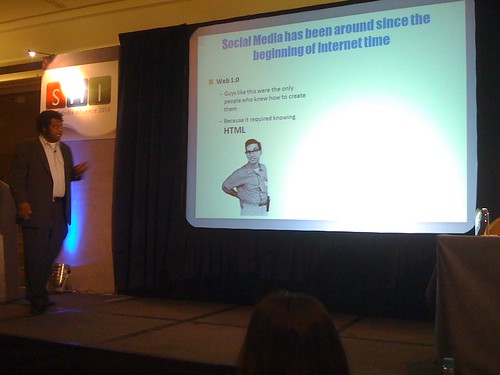I’m live-blogging from the fifth annual Social Media Influence conference at The Marriott Hotel, London. There are two tracks: “Social Media Influence” and “Social Business Design” – I’m starting out in the second track but aim to move between the two. Keep refreshing this page for updates.
9.15am: Headshift’s Lee Bryant kicks off with an intro – we’re told we’re in the serious track – “far more intelligent than the fluffy bunnies next door (but please don’t tell them I said that)!”. Poor Lee. I guess he has to say something as there are only about 20 of us in here – the rest have been lured by the bright lights of the larger ballroom.
9.19: JP Rangaswami: the business value social media creates for the enterprise – the assets. (2) the business models themselves, rather than just talking about the ROI. (3) the context in which we operate. What a social network actually is within the enterprise. (4) The dimensions. The A, B, C and the D!
9.25: Social media starts with the address book. The telephone companies were sitting on these assets for ages – they had the directory, the classification and the modality for communication. Why did it take somebody like Microsoft to see that if you had everyone’s contact details on your database, you can enable them to schedule events between them? Why did it take companies like Microsoft and Bloomberg to add the ability to schedule?
9.29: the reason wikis and blogs worked when the original intranet didn’t is because intranets were put together by a limited number of people with already out of date information. Who knows my address or my condition better than I do? Who knows better than me than to describe my status as “it’s complicated”? It’s taken a long time for us to realise that this type of descriptor is useful in an enterprise context.
9.38: Expert systems and KM failed because they were all good ideas, but we always focused on the “where is the value” argument – this deflected from the fact that they were simply every day work. You can’t use terms like Yammer and Jabbr and Twitter – they don’t sound businessy. They don’t have the gravitas of Microsoft Powerpoint. Your first response when trying to design for value in the enterprise is: this is not anything new.
9.40: Business models: I hate the phrase ‘business model’. Peter Drucker used to say, “people make shoes, not money”. There is always a market for what you are good at. Do what you’re good at. A lot of business models are “pay per drink”; others are “eat all you can”; the third model is “somebody else pays”. Generally, either a transaction model or a subscription model.
9.46: How many of you remember using internet when there was only ISDN? Tendency was to get on there, do something very quickly then get out. Human beings dont’ like the concept of leaving the taxi meter running. In late 1990s UK and Europe were held back because we had ‘pay per drink’ internet and not ‘eat all you can’ (like the US).
9.49: we are building these [social business] services every day, we just don’t realise it. It wasn’t that look ago, when finding the email you wanted was impossible. We’ve got better because our kinds are more likely to be online than offline; storage is so cheap. The relationship we have with data is so much better.
9.51: Terms like ‘cost centres’ and ‘profit centres’ are all lies: the only revenue is when someone outside the firm pays money for something within the firm. Someone like [Facebook’s] Mark Zuckerberg really understood that the thing that we value as we move into the 21st century is: RELATIONSHIPS.
9.53: All business is about conversations (not just marketing). I’m glad Euan is here because the first time we met on stage was when we were discussing the impact of the Cluetrain Manifesto [update: you can watch that conversation here]. It’s the way we always did business: directory, modality, record changes, means of scheduling…the tools we used were the same, it’s just they’ve got better. Thanks to Moore’s Law and Metcalfe’s Law etcetera. We must each remember: I’m not doing anything new. If we do that, we get rid of so much of the noise that holds all this up.
10am: Now up, it’s a panel discussion chaired by Euan Semple. Panellists: Steve Perry, Sonia Carter and David Christopher.
Euan: I’m a bit uncomfortable with the word “design” because it doesn’t convey all the messiness and guerilla activity that is really driving social media in business.
Steve Perry (Knowledge and IM advisor): I was working with (leading London-based law firm) Freshfields focusing on improving collaboration. We had an ‘aha’ moment when we realised that the Confluence wiki could be the intranet, because the intranet is simply a series of community spaces – the previous intranet was very static, very dry and boring. We wanted partners, everyone to start working ‘in the flow’ and contributing comments, insights as they were working. If you can do that, the end result is much more shared collective intelligence and knowledge.
10.04: I came up with an approach called ‘tight/ loose’ – we used standard branding: company name etc, but the feature I really wanted them to use was ‘latest news’ – gives it a blogging feel.
10.07: I wanted to get people out of the habit of using email, and revising documents using email. We got people to start creating their documents in the wiki. Getting them out of email and into the wiki was the crucial thing. The other thing was getting them to use the discussion forums. I got the US partners to start using these for strategy work.
10.08: A couple of things we would have done differently: (1) build a coalition: get other departments on board: risk, finance etc. We had budget approval but we came up with a lot of objections from other depts that I should have dealt with at the beginning. (2) initiated more two-way communication between users and the central team. I should have done more work running workshops, spending face time with other users. (3) identified more busines processes which would benefit from the wiki. (4) agreed earlier how to measure and monitor usage. (3) planned content migration in more detail.
What worked well? The “tight/loose approach”. the fact it was a clear business need and part of firms’ strategy. Did not over promise (so we exceeded expectations). Earlier with KPMG we pitched a project very high, so perception was that it didn’t deliver.
10.13: overall result: increased intranet use and particpation. One example: The Frankfurt based Porshe team: they were wrestling with a legal issue with Porshe. Someone in London added a point [to the query posted up on the wiki], someone in New York built on it later that day, the guys in Frankfurt woke up the next morning with two or three real nuggets of good ideas that they could take back to Porshe. This was a job worth 100s of 1000s of £ to Freshfields.
10.16: Sonia Carter, AXA UK: if we can make these things succeed in a company that’s very conservative with lots of employees very demotivated (in current climate), then its a great example of social media. How do we do things? Sometimes by stealth. Also, sometimes we’ve been able to piggy-back on a big project. Where we’ve hit challenges is in the huge amount of process being involved – this can drive costs up exponentially. Security, IT, procurement, legal etc can add months and months on. Bigger projects where we’ve taken waterfall approach and crossed every T and dotted every i take months and months. The agile approach works better.
10.20: employee engagement is quite fluffy in the nicest sense: no-one’s too interested in measurement, people have a gut-feeling as to whether it’s improved or not. There have been a few projects in AXA that have focused on employee engagement and we’ve piggy-backed on the back of them.
A lot of our innovation has started internally – we’re still rather nervous about engaging directly with customers, mainly because of compliance and legal shackles. We have a lot more free rein within the firewall.
Our journey using social tools for employee engagement started 2 and a half years ago. Huge employee engagement initiative getting employees to understand importance of customer. We do act in a very silo’ed way – not great for customer. They talk to someone about pensions and want to talk to that same person about healthcare. After this initiative had run a few months, people were coming back from training very engaged, but we didn’t have anythign to facilitate that. There wasn’t any forum, just email and clunky old directory all very top down. People were coming back very fired up and nowhere to channel that excitement. For a few hundred pounds we built a system called “Ourspace” – incorporated Dell’s Idea Storm – a while back, not too many people had these internal ideation systems. Used WordPress and a load of plugins to build it. We rolled it out in six weeks. Only people who’d come back off the customer-centric training could get a log-in. We were very light touch, with an acceptable use policy which we tied into other workplace policies. In two years we’ve only removed four or five posts. If people post using their own name, you don’t need to give people reams and reams of usage guidelines. These forums have now become an intrinsic part of the business. Example: the news broke that a buyer was interested in buying the company, within 24 hours we had the CEO of the business concerned on the forum answering everyone’s questions. Everyone felt unhappy they hadn’t known about this but this turned the situation around.
10.28: Something called “Red button” – we got users to put up a red flag to mark anything that was confusing or hindering the customers. Now brokers let us know what’s not working in the sort of policies we offer them. Also “Blue button” – in insurance we have a very engaged CEO who really loves social tools so makes pushing anything forward there very easy. Something with Headshift: “You Prove” – we got employees to make videos about how they were fulfilling various corporate values – in a much more engaging way, eg: “When was last time you made customer smile?” This has worked very well.
10.35: David Christopher, Oracle / Founder, stop!thinksocial: shows Slideshare presentation Social Media In Business: it’s just a bunch of tools, right?. His mantra is simple: It’s not about the tools, it’s about the people!
He advocates the POST process designed by Forrester analysts (as recommended in the book, Groundswell).
David finishes with his five top tips:
1. Find the hook (eg: I can reduce your email by 50%)
2. Start small: quick win, big impact
3. Be creative – use social media to demonstrate the power of social media
4. Be passionate
5. Stop!thinksocial – before you send off that big attachment, stop and think is there are more social way of doing this?
11am: Break for coffee.

